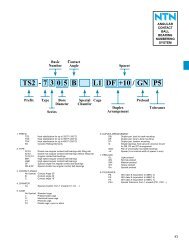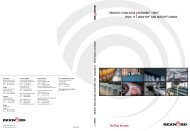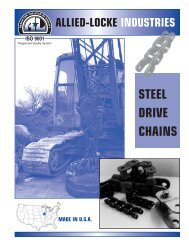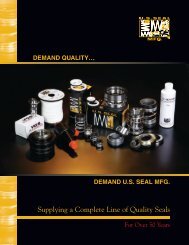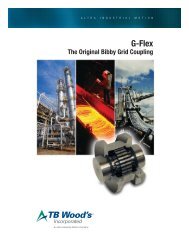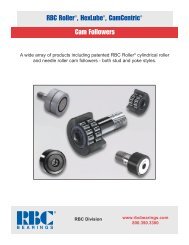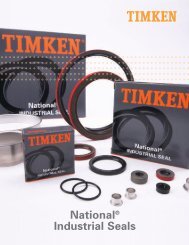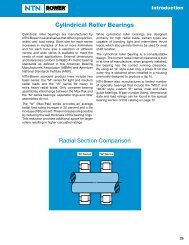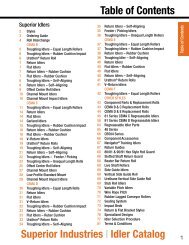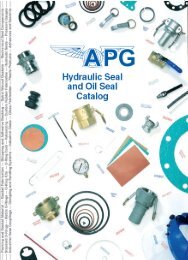Rex Linkbelt Roller Chain Catalog - Norfolkbearings.com
Rex Linkbelt Roller Chain Catalog - Norfolkbearings.com
Rex Linkbelt Roller Chain Catalog - Norfolkbearings.com
- No tags were found...
Create successful ePaper yourself
Turn your PDF publications into a flip-book with our unique Google optimized e-Paper software.
LubricationThe primary purpose of chain lubricationis to provide a clean film of oil at all loadcarrying points where relative motionoccurs. This is particularly importantduring the initial break-in period whenthe wear characteristics of the chain arebeing established. Consequently, mostchains are pre-lubricated at the factoryunless otherwise specified.To be effective, subsequent lubricationmust be directed to the bearing surfacesas shown in Figure C-147.Between the sidebars to thepin-bushing bearing surface<strong>Roller</strong> chainsall typesInside the rollerAs a general rule, lubrication of conveyorand elevator chains is necessary toobtain adequate chain life. However,there may be some applications wherelittle or no lubrication is permissible. Meatpacking and food processing plants aretypical examples where contamination ofthe conveyed material must be avoided.Likewise, the presence of lubricant in avery dusty or abrasive environment couldbe a deterrent to long chain life. In thesecases, lubrication decisions must oftenbe based on actual experience.Selection of the lubricantFig. C-147Conveyor and elevator chains operatingat room temperature should generallybe lubricated with a straight mineral oilof S.A.E. viscosity number 30. Lower orhigher ambient temperatures require oilswith lower or higher viscosity numbers,respectively.The following operating conditionsrequire special lubricants:Elevated temperatures • Petroleumoils should not be used to lubricateconveyor or elevator chains operating intemperatures exceeding 300°F (149°C).Under certain conditions, chainsoperating in high-temperatureatmospheres can be effectivelylubricated with colloidal graphitedispersed in a suitable volatile carrier.The solution penetrates the chain jointsand, upon evaporation of the carrier,leaves a thin deposit of graphite on thechain joint surfaces. The lubricant maybe applied by drip-feed cups, providedagitation is used.Consult a lubricant manufacturerfor re<strong>com</strong>mendations when chainsare required to operate at elevatedtemperatures.Corrosion • The effect of unusualcorrosion conditions can sometimes bereduced with special lubricants. Consult alubricant manufacturer for a material thatis not soluble in the corrosive element.High loads • When chain joints aresubject to high unit bearing loads, usean “EP” oil. This type of lubricant hasan extreme pressure additive that helpsmaintain a cushioning film of oil betweenjoint <strong>com</strong>ponents.Methods of lubricationIt is difficult and generally impractical toprovide protective housings for chainsapplied to conveyors and elevators. Theyare usually operated in the open andexposed to the material being conveyed.Therefore, applying a lubricant is difficultunder some operating conditions.Various methods are used to lubricateconveyor and elevator chains. The natureof the surrounding atmosphere is theprincipal consideration in selecting thebest method to use.Clean atmosphere • <strong>Chain</strong>s operatingin a relatively clean atmosphere canbe lubricated manually or by a semiautomaticmethod using drip cups.The lubricant may be applied manually99with a brush or spout-type oil can to thespaces shown in Figure C-147.With the semi-automatic method,dripcups are usually mounted on a pipewith drilled holes spaced to distribute oilbetween the sidebars in the lower spanof chain. About 4 to 10 drops per minuteare usually sufficient to lubricate slowspeedconveyors. It will take about onehour to drop one ounce of oil at the rateof 10 drops per minute.Atmosphere laden with lint or nonabrasivedust • Where large volumesof lint or non-abrasive dust are present, abrush or wiper can be used to clean thechain and apply the lubricant. Otherwise,the lint or dust will clog the chain jointclearances and prevent the oil frompenetrating into the joints. This typeof lubrication can be made to operateautomatically.Abrasive atmosphere • If abrasives<strong>com</strong>e in contact with the chain,lubrication be<strong>com</strong>es more difficult. Whenlubricants are applied externally, abrasiveparticles tend to adhere to the chainsurfaces and act as a lapping or grinding<strong>com</strong>pound. Under extreme conditions,it is sometimes advisable to avoid chainlubrication.<strong>Chain</strong>s operating in an abrasiveatmosphere can often be lubricatedwith a neutral petroleum jelly such aspetrolatum, or with various other nonfluidlubricants such as greases with orwithout molybdenum disulfide or colloidalgraphite additives. When properlyheated, these lubricants are sufficientlyfluid to penetrate the chain joints, but atnormal temperatures are solid enoughto hinder the entrance of abrasivematerials.To lubricate a chain with petroleum jellyor non-fluid greases, heat the lubricantuntil fluid. Immerse the chain and allowit to soak until air bubbles cease to rise,thus indicating that the lubricant haspenetrated the chain joints. Allow thechain to remain submerged until thelubricant is partially solidified to preventthe lubricant from draining out of thejoints when the chain is removed. Beforerelubricating, thoroughly clean chain toremove all dirt and abrasives.EE-9




